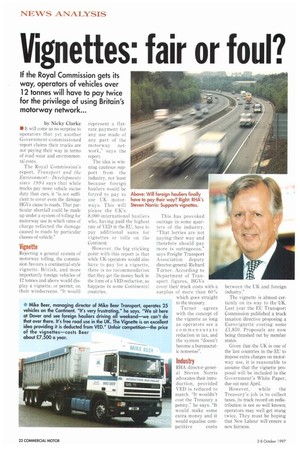Vignettes: fair or fou
Page 24

If you've noticed an error in this article please click here to report it so we can fix it.
by Nicky Clarke • It will come as no surprise to operators that yet another Government-commissioned report claims their trucks are not paying their way in terms of road wear and environmental costs.
The Royal Commission's report, Transport and the Environment—Developments since 1994 says that while trucks pay more vehicle excise duty than cars, it "is not sufficient to cover even the damage HGVs cause to roads. That particular shortfall could be made up under a system of tolling for motorway use in which rates of charge reflected the damage caused to roads by particular classes of vehicle."
Rejecting a general system of motorway tolling, the commission favours a continental-style vignette. British, and more importantly foreign vehicles of 12 tonnes and above would display a vignette, or permit, on their windscreens. "It would represent a flatrate payment for any use made of any part of the motorway network," says the report.
The idea is winning cautious support from the industry, not least because foreign hauliers would be forced to pay to use UK motorways. This will please the UK's 8,000 international hauliers who, having paid the highest rate of VED in the EU, have to pay additional sums for vignettes or tolls on the Continent.
However, the big sticking point with this report is that while UK operators would also have to pay for a vignette, there is no recommendation that they get the money back in the form of a V1,21) reduction, as happens in some Continental countries.
This has provoked outrage in some quarters of the industry. "That lorries are not paying their way and therefore should pay more is outrageous," says Freight Transport Association deputy director-general Richard Turner. According to Department of Transport, figures, HGVs cover their track costs with a surplus of more than 60% which goes straight to the treasury.
Turner agrees with the concept of the vignette as long as operators see a commensurate reduction in tax, and the system "doesn't become a bureaucratic nonsense".
RHA director-general Steven Norris advocates their introduction, provided .F.D is reduced to match. "It wouldn't cost the Treasury a penny," he says. "It would make some extra money and it would equalise com
petitive costs between the UK and foreign industry."
The vignette is almost certainly on its way to the UK. Last year the EU Transport Commission published a truck taxation directive proposing a Eurovignette costing some £1,850. Proposals are now being thrashed out by member states.
Given that the UK is one of the last countries in the EU to impose extra charges on motorway use, it is reasonable to assume that the vignette proposal will be included in the Government's White Paper, due out next April.
However, while the Treasury's job is to collect taxes, its track record on redistribution is not so well known; operators may well get stung twice. They must be hoping that New Labour will ensure a new fairness.








































































































